A healthy savory butternut squash casserole sweetened with dried fruits and sweet potatoes, complemented by earthiness of brown and wild rice, and finished with balsamic notes. Experience a harvest flavor explosion in every bite of this recipe creation. The butternut squash casserole is naturally vegan and everyone will rave about it if you prepare it for your Thanksgiving lunch or dinner.

Butternut Squash Casserole Recipe Overview
Reproducing the flavors of my savory twice baked sweet potatoes recipe, this butternut squash casserole brings together the sweet overtones of balsamic, creating a harmonious blend of savory and sweet. It’s the ideal side dish or meal to serve during the fall or festive seasons.
If you’re on the hunt for delicious butternut squash casserole recipes or perhaps recipes combining roasted butternut squash and sweet potato, then you’ve landed in the perfect spot.

This dish is a top pick among my vegan butternut squash recipes, besides this butternut squash soup, it’s simple, easy, and solely incorporates whole food components, being naturally gluten-free and dairy-free! For those who lean towards a dish with a creamier and more savory flair, I recommend exploring this vegan potato bake / casserole. I also like to pair these kind of hearty dishes with some tangy fermented veggies like these fermented tomatoes, dill pickles or sauerkraut.
Also, for those intrigued by hearty, flavorful casseroles, don’t forget to check out my Lazy Cabbage Roll Casserole.
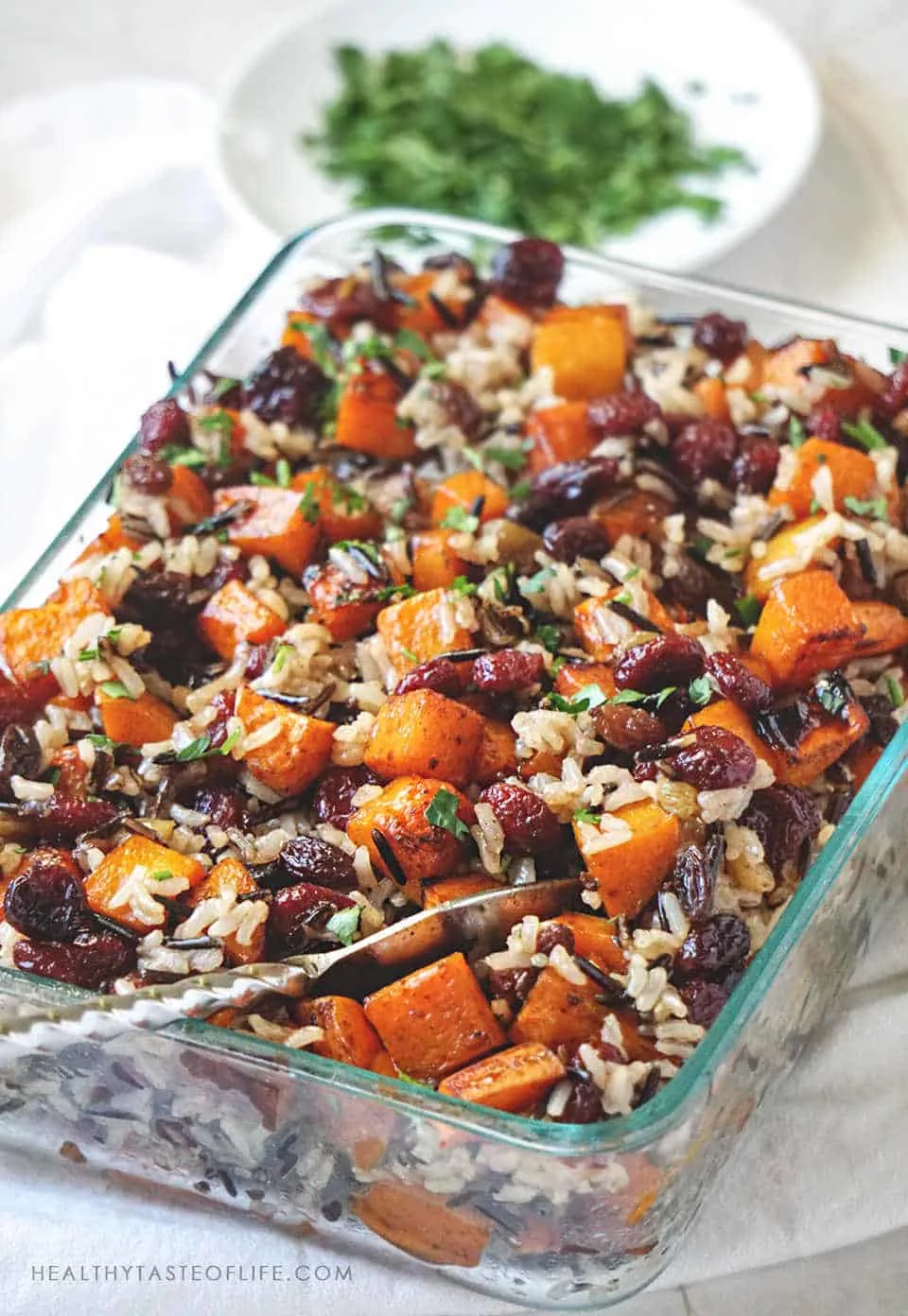
Make sure to check these 5+ Nutritious Beetroot Salad Recipes they would pair well with this casserole dish!
Combining Fall Flavors: Sweet Potatoes & Butternut Squash in a Casserole
This butternut squash casserole is a flavorful, comforting blend of caramelized butternut squash, sweet potatoes, a mix of brown and wild rice, dried cranberries, raisins, and a sweet cinnamon glaze; it’s the quintessential warm and filling dish ideal for the fall season, making it a perfect addition to your Thanksgiving dinner or any festive season gathering.
Related: Spaghetti Squash + Chicken & BBQ Sauce
Healthy Butternut Squash And Sweet Potato Casserole Recipe
So let’s uncover the steps to creating this savory butternut squash casserole, a vegetarian and vegan friendly dish that’s bound to have everyone at the table asking for seconds.
Heads up: some links are affiliated & I may receive a small commission from qualifying sales. For more info see my disclaimer policy.

Also see: Meal Prepping Vegetables: How to Keep Veggies Fresh Longer
Essential Ingredients for This Butternut Squash Casserole
- Butternut squash The star of this casserole, butternut squash brings sweetness and a creamy texture, enhancing the dish’s overall richness. Acorn squash or Delicata squash would also work;
- Sweet potato (or yams); Sweet potatoes add a hearty, sweet depth, complementing the squash with their earthy tones and soft texture.
- Dried cranberries These are the sweet and tart jewels in the casserole, contributing both vibrant color and contrasting flavor.
- Golden raisins (or other dried fruit); Golden raisins introduce a sunny, sweet element, adding layers of texture and a subtle fruity undertone.
- Brown rice (short or long grain both work)– Brown rice serves as the wholesome, fibrous base, balancing out the sweetness with its nutty flavor. Short grain provides a slightly stickier texture.
- Wild rice (or brown basmati rice, if you can’t find the wild type); Wild rice brings a unique, chewy texture and a layer of earthy, nutty flavors to the casserole.
- Extra virgin olive oil (or avocado oil): This oil binds the ingredients together, adds moisture, and enhances the flavors with its neutral, healthful profile.
- Balsamic vinegar (or apple cider vinegar) – Balsamic vinegar imparts a sweet and tangy note, accentuating the natural sweetness of the fruits and vegetables.
- Spices (nutmeg, cinnamon, black pepper, salt): These spices meld to create a warming, aromatic blend that elevates the dish with notes of sweetness, heat, and savory depth.
You Might Also Like: Pumpkin And Beetroot Salad (Vegan)
How To Make The Butternut Squash Casserole
Step 1. Prepare:
- Preheat oven to 400F (205C), line a large baking sheet with parchment paper. We’re going to roast the veggies first.
- Since both butternut squash and sweet potato tend to turn mushy while cooking, it’s best to roast them first and cook the brown rice and the wild rice separately so they don’t stick together. Therefore the butternut squash casserole will stay fluffy and textured allowing to taste each of the flavors separately.
Step 2. Make the sauce:
- In a small bowl combine the oil, maple syrup, vinegar, cinnamon, nutmeg, salt and pepper. Stir to combine. Set aside.
Step 3. Coat the veggies with sauce and bake:
- In a large bowl, combine cubed butternut squash (peeled and seeded), cubed sweet potatoes (peeled), and half of the seasoned sauce mixture you made earlier, toss to coat.
- Place the cubed veggies in a single layer on the baking sheet (use 2 baking sheets if necessary) to get an even roast on all sides. Bake for 30-35 minutes, turning once half-way through baking, until softened and with a golden brown crust.
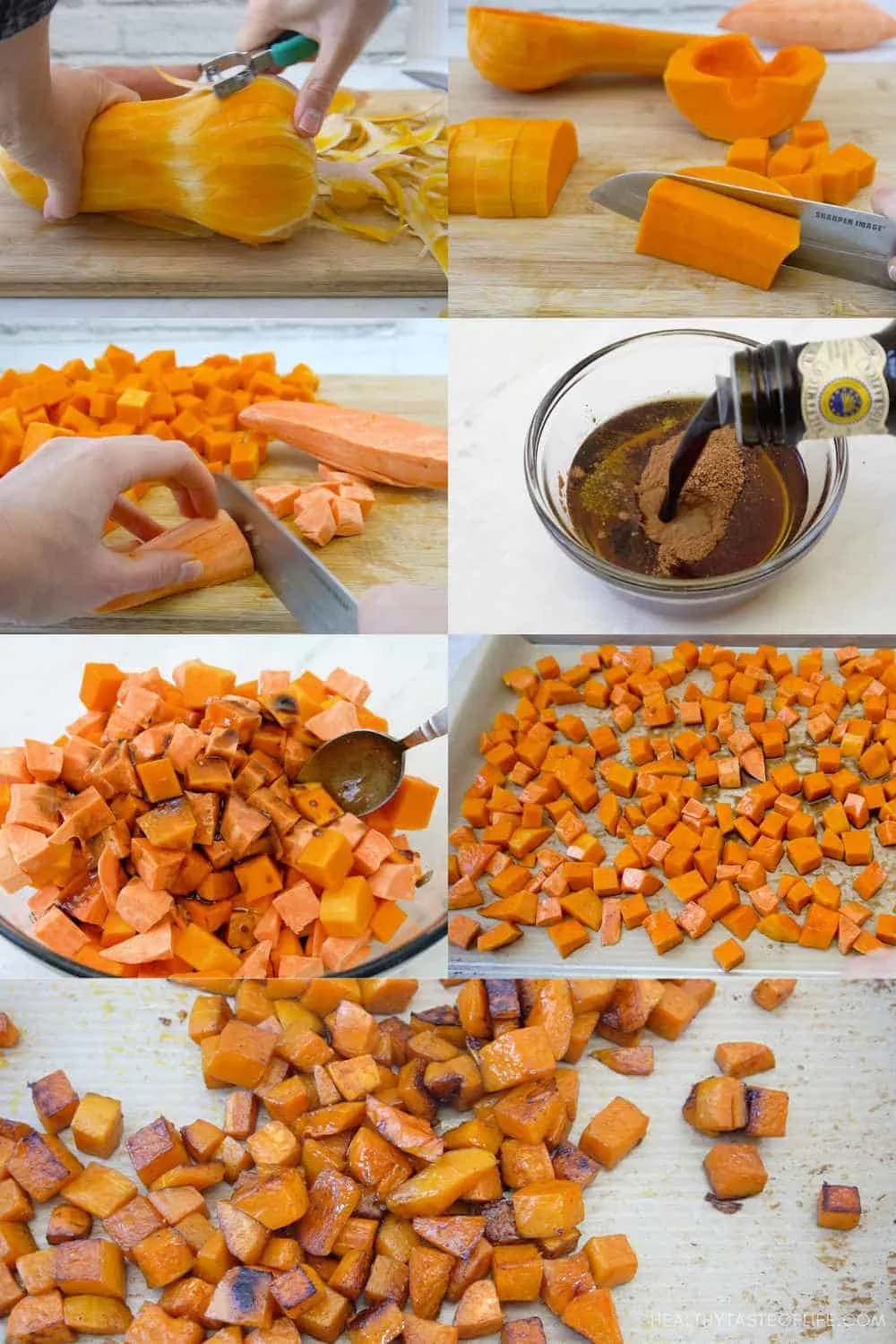
How to Achieve Perfectly Caramelized Roasted Veggies
When baking the butternut squash and sweet potato cubes take into account their size: if they’re about 1 inch in size, you need to bake them 25 minutes at 400 F. Larger cubes, about 35-40 minutes. Bake until they’re tender and lightly caramelized.
Step 4. Cook the rice with dried fruits:
- Meanwhile the veggies are roasting you can cook the rice.
- Place the rinsed wild rice in a pot with boiling water (if your rice is pre-soaked, use a 2 to 1 water-to-rice ratio, or 3 to 1 ratio if it’s not). Place the wild rice first as it needs to cook for about 10 minutes longer than the brown rice.
- Add the other half of the sauce mixture you used for coating the veggies to the rice, stir, cover the pot with the lid, and reduce the heat to its very lowest setting to help the rice cook evenly (for about 20 minutes). Remove from heat, add the cranberries and the raisins. Cover again and let it sit covered, so the steam will plump the rice and fruits.
Step 5. Assemble the butternut squash casserole:
- To arrange the meal and serve, take a taller baking dish (I used a glass dish) and place a layer of veggies, then a layer of rice and repeat until you fill up the dish. Sprinkle some chopped greens on top. Serve warm or cold.

Serving Suggestions
When serving this delightful Butternut Squash Casserole, consider pairing it with dishes that complement its sweet and savory flavor profile. For a protein-packed companion, this Healthy Chicken Fritters or Stuffed Chicken Roll Ups would make delicious partners, balancing the richness with their light and savory notes. The Shrimp Cabbage Salad or the Chicken Salad with Cranberries, Walnuts, & Avocado can add a refreshing, crunchy contrast to the soft and creamy casserole. For our vegan friends, the Creamy Chickpea Salad With Cabbage and the Roasted Brussels Sprouts and Asparagus with a Tangy Sauce would be harmonious pairings, adding varied textures and flavors to your meal, making your dining experience a gourmet delight.
Tips For Making This Butternut Squash & Sweet Potato Recipe
- To save time you can find at the grocery store – butternut squashes that have been peeled and chopped already.
- Cook the rice while the vegetables are roasting in the oven so you get them ready at the same time.
- The brown rice cooks in shorter time than wild rice and may become too soft or mushy if you cook them together. Is best to start cooking the wild rice 6-8 minutes before adding the brown rice to the pot. To cut the cooking time in half, try to soak the rice a few hours before cooking (or overnight), especially the wild rice.
- If your rice is pre-soaked the liquid to rice ratio should be 2:1; if it’s dry then – 3:1.
Video: Watch How To Make This Butternut Squash Casserole
If you can’t see the video, try to disable your ad-blocker in your browser.
Add-Ins And Substitutions
- This butternut squash and sweet potato casserole would be even more hearty if you add some nuts, seeds, herbs or even some protein like beans or meat (if you’re not vegan). I even contemplated on adding some apple chunks, they would caramelize beautifully as well.
- If you want to remove some of the oil and sugar that the dried fruits have been soaked in, then place them in water for an hour or so, and rinse several times. This will also help them be plump and juicy when added to the dish.
Tip: More Savory Notes
If you prefer a more savory dish than opt for savory herbs, nuts, seeds, and maybe some stock – as the liquid for this butternut squash casserole recipe.
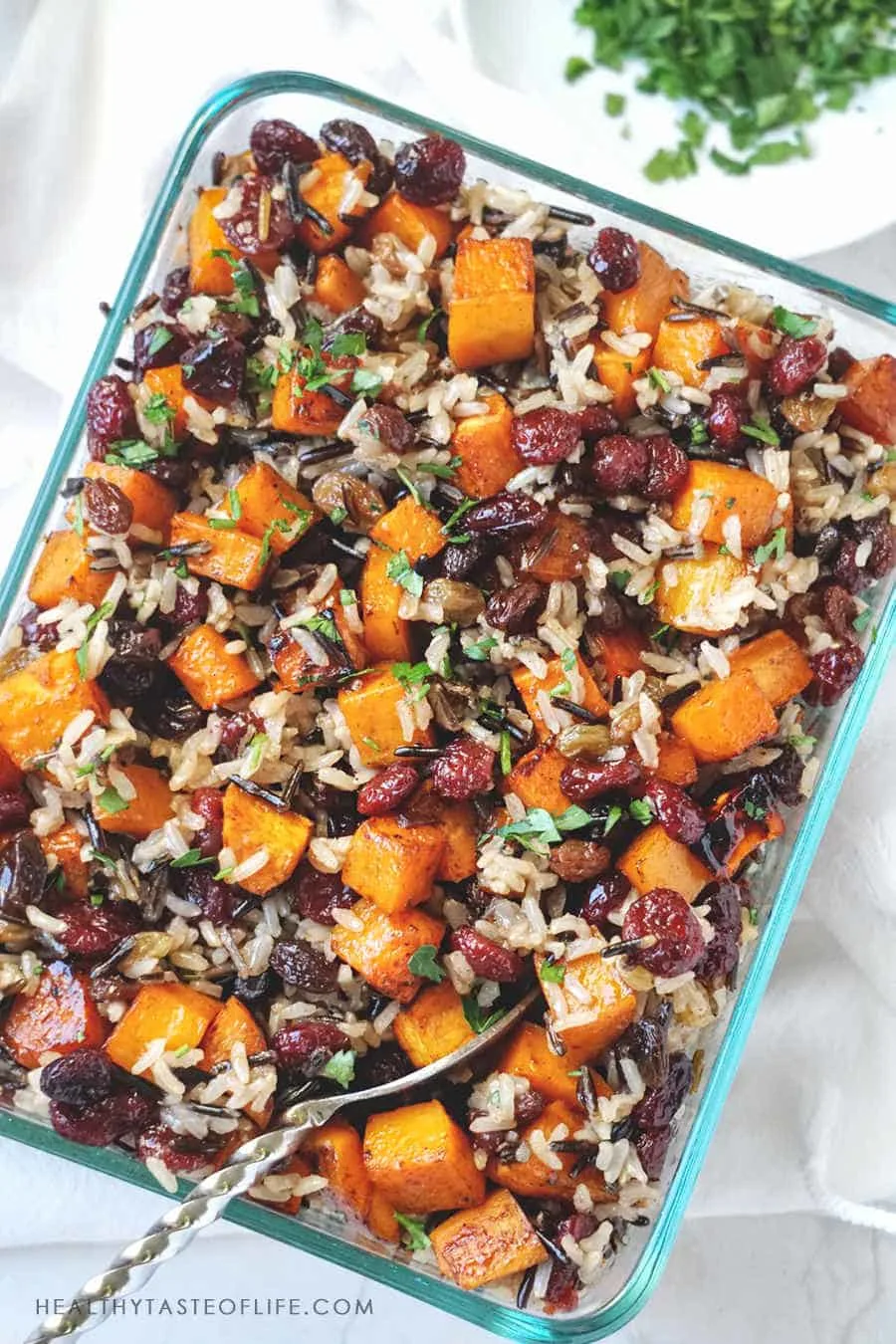
Make In Advance And Save Time
This butternut squash casserole recipe reheats beautifully or can be served cold as it is. If making in advance, then store the roasted vegetables and cooked rice in an airtight container (separate or together, it doesn’t matter as long as you don’t add herbs) in the refrigerator. If you want to add extra ingredients, it’s best to add them after reheating.
Storing
Store any leftover casserole in an airtight container in the refrigerator for up to 4 days. Reheat in the oven or microwave until warmed through before serving.
FAQs
This Butternut Squash Casserole is healthy because it’s made with wholesome ingredients like butternut squash, sweet potatoes, brown and wild rice, and dried fruits and it’s not overly sweet. It is naturally vegan, gluten-free, and dairy-free, making it suitable for various dietary preferences.
It’s primarily a casserole. Traditional casseroles use ingredients like cheese or eggs for binding, but this vegan version relies on caramelization and texture, with ingredients being both baked and boiled. It’s served in a casserole dish, emphasizing its categorization as a casserole. The name is up to personal preference; what matters most is the harmonious blend of flavors you experience when you try it!
This casserole is a hearty and flavorful option for anyone following a vegan diet as it contains no animal products and is rich in plant-based ingredients.
Yes, you can freeze the casserole. Ensure it is cooled completely before transferring it to a freezer-safe container. It can be frozen for up to 2 months. Thaw overnight in the refrigerator and reheat before serving.
Definitely! Feel free to add or substitute with vegetables of your choice like carrots, Brussels sprouts, or asparagus to make the casserole more nutritious and colorful.

Indulge in the Flavors: Enjoy Your Vegan Butternut Squash Casserole!
This casserole is a delightful fusion of sweet and savory, making it an ideal centerpiece or side for any meal. Its rich flavors pair effortlessly with various dishes, ensuring every bite is a celebration of taste. Let this butternut squash dish elevate your dining experience!
More Healthy Dinner Recipes For Fall And Holiday Season
If you made this Butternut Squash Casserole please leave a comment and rating below the recipe.
It would be really helpful for me and readers. Thank you!
Printable Recipe
Butternut Squash Casserole With Sweet Potatoes and Rice Recipe
Ingredients
- 1 medium butternut squash - peeled, cubed
- 1 large sweet potato - cubed, or two medium
- ¾ cup dried cranberries
- ½ cup golden raisins
- ½ cup brown rice - short grain or long grain
- ¼ cup wild rice
- ⅙ tsp nutmeg
- 1 tsp cinnamon
- ¾ tsp sea salt
- ¼ tsp black pepper
- 3 tbsp maple syrup
- 3-4 tbsp extra virgin olive oil - or avocado oil
- 1 ½ -2 tbsp balsamic vinegar - or apple cider vinegar
Instructions
- Preheat oven to 400 F. Prepare a parchment paper lined baking sheet, the larger the better.
Make The Sauce
- In a small bowl combine the oil, maple syrup, vinegar, cinnamon, nutmeg, salt and pepper. Stir to combine. Set aside.
Coat the veggies with sauce and bake:
- In a large bowl, combine cubed butternut squash (peeled and seeded), cubed sweet potatoes (peeled), and half of the seasoned sauce mixture you made earlier, toss to coat.
- Place the cubed veggies in a single layer on the baking sheet (use 2 baking sheets if necessary) to get an even roast on all sides. Bake for 30-35 minutes, turning once half-way through baking, until softened and with a golden brown crust.
Cook the rice with dried fruits:
- Meanwhile the veggies are roasting you can cook the rice.Place the rinsed wild rice in a pot with boiling water (if your rice is pre-soaked, use a 2 to 1 water-to-rice ratio, or 3 to 1 ratio if it’s not).
- Place the wild rice first as it needs to cook for about 10 minutes longer than the brown rice.
- Add the other half of the sauce mixture you used for coating the veggies to the rice, stir, cover the pot with the lid, and reduce the heat to its very lowest setting to help the rice cook evenly (for about 20 minutes). Remove from heat, add the cranberries and the raisins. Cover again and let it sit covered, so the steam will plump the rice and fruits.
Assemble the butternut squash casserole:
- To arrange the meal and serve, take a taller baking dish (I used a glass dish) and place a layer of veggies, then a layer of rice and repeat until you fill up the dish. Sprinkle some chopped greens on top. Serve warm or cold.
Video
Notes
Tips For Making This Vegan Butternut Squash Casserole
- To save time you can find at the grocery store – butternut squashes that have been peeled and chopped already.
- When baking the butternut squash and sweet potato cubes take into account their size: if they’re about 1 inch in size, you need to bake them 25 minutes at 400 F. Larger cubes, about 35 minutes. Bake until they’re tender and lightly caramelized.
- Cook the rice while the vegetables are roasting in the oven so you get them ready at the same time.
- The brown rice cooks in shorter time than wild rice and may become too soft or mushy if you cook them together. Is best to start cooking the wild rice 5-7 minutes before adding the brown rice to the pot. To cut the cooking time in half, try to soak the rice a few hours before cooking (or overnight), especially the wild rice.
- If your rice is pre-soaked the liquid to rice ratio should be 2:1; if it’s dry then – 3:1. The rice is fully cooked when the grains are tender but still chewy and beginning to split. If there is any liquid left, drain it.
- If you want to remove some of the oil and sugar that the dried fruits have been soaked in, then place them in water for an hour or so, and rinse several times. This will also help them be plump and juicy when added to the dish.
Nutrition
The information shown is an estimate provided by an online nutrition calculator.
©HealthyTasteOfLife. Content and photographs are copyright protected and need prior permission to use. Copying and/or pasting full recipes to other websites and any social media is strictly prohibited. Sharing and using the link of this recipe is both encouraged and appreciated!





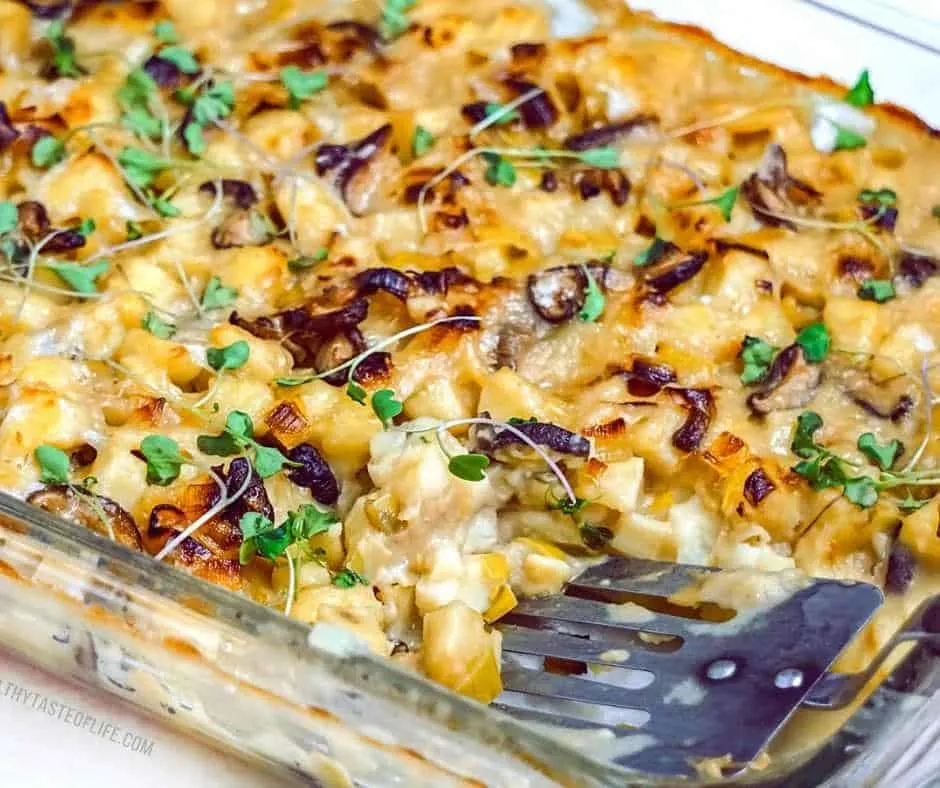
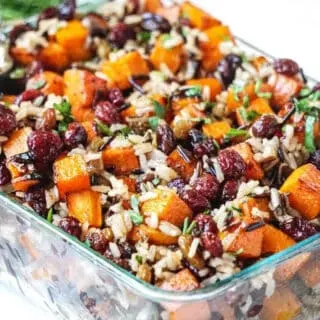
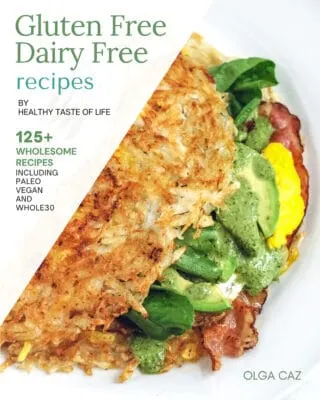
Lisa
Thursday 21st of November 2024
My family really liked this! Smelled wonderful while cooking and tasted delicious.
Olga Caz
Tuesday 17th of December 2024
Thank you you for your feedback!
Patricia Turner
Tuesday 19th of November 2024
This is a beautiful combination of flavors. I did use Uncle Ben's wild rice ready rice as a short cut and I used smoky pecan maple syrup. The dish was loved by all and I'm making it again for Thanksgiving. Thank you!!
Melissa
Thursday 24th of November 2022
I substituted the raisins with currants because raisins are a migraine trigger for a family member.
Melissa
Thursday 24th of November 2022
Making this right now for Thanksgiving dish but adding some roasted beets to this dish also. So far it's turning out terrific.
Karen
Monday 14th of November 2022
I loved this recipe. I only used 1/2 cup of golden raisins and craisins and only used 2 tbl of maple syrup and oil. So easy and delicious!! Will be making for Thanksgiving!